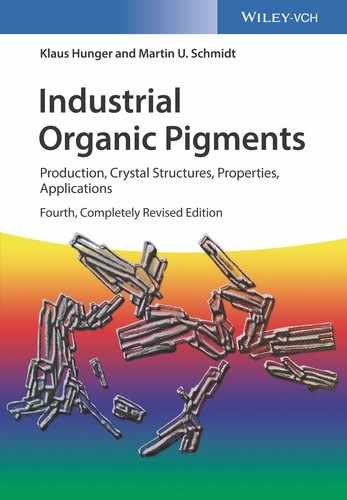Preface to the Fourth Edition
All chapters in the fourth edition have been thoroughly reviewed, revised, and updated. More than 130 formulae were added or revised. About 170 figures were added. The chapter on legislation, ecology, toxicology was completely rewritten and now represents the latest developments.
Actually “Azo pigments” do not exist. All single-crystal structure analyses as well as spectroscopic investigations reveal that no commercial “Azo pigment” contains an azo group, but they exhibit the hydrazone-tautomeric form instead1). Consequently all commercial “azo pigments” should be called “hydrazone pigments”. This nomenclature has been employed throughout this book. We hope, that the correct denomination “hydrazone pigment” finds its way to all publications on organic pigments as well as to the labelling of products etc.
The properties of organic pigments depend on their crystal structures. Correspondingly all available information on the crystal structures of all industrial organic pigments has now been included and almost every crystal structure is depicted by a figure. The effect of the crystal structure and the polymorphism of a pigment on its colouristic and physical properties is described in detail. The new co-author of this book, Prof. Dr. Martin U. Schmidt, has been researching organic pigments since 1995, with a focus on their polymorphism and their crystal structures.
Several sections have been moved to other chapters in the 4th edition. Most triarylcarbonium pigments and most metal complex pigments are neither hydrazone nor polycyclic pigments, hence their description now appears in chapter 4 (Miscellaneous Pigments). The section on isoindoline and isoindolinone pigments has been moved to chapter 3 (Polycyclic Pigments).
We pay tribute to our deceased colleagues Dr. Willy Herbst, who was the former coauthor of the book, and Prof. Dr. Erich F. Paulus (Goethe University, Frankfurt, formerly at Hoechst AG), who worked on polymorphism and single-crystal structure analyses of organic pigments for 43 years.
The layout process for the fourth edition required considerable effort, both by the authors and the publisher, resulting in more than 10 consecutive proofs within a period of 5 years.
The authors thank Dipl.-Ing. Thomas Heber, Dr. Friedrich Reisinger, and Stefan Wannemacher (all from Clariant) for the review and revision of the sections 1.6 to 1.8 and updates in several other sections. We express our gratitude to numerous present and former colleagues at Clariant for many years of kind and intense cooperation, in particular Dr. Dieter Schnaitmann and Dr. Wolfgang Schwab for information on quinacridones and other polycyclic pigments, Dr. Hans Joachim Metz for information on hydrazone pigments, especially quinazolinediones, and Dr. Hans-Tobias Macholdt for information on non-impact printing. Dipl. Chem. Tanja Trepte (formerly at Goethe University) is kindly acknowledged for drawing the new formulae, and Dr. Stephanie Cronje (Goethe University) for improving the English.
| Kelkheim and Frankfurt am Main, 2018 | K. Hunger, M.U. Schmidt |
